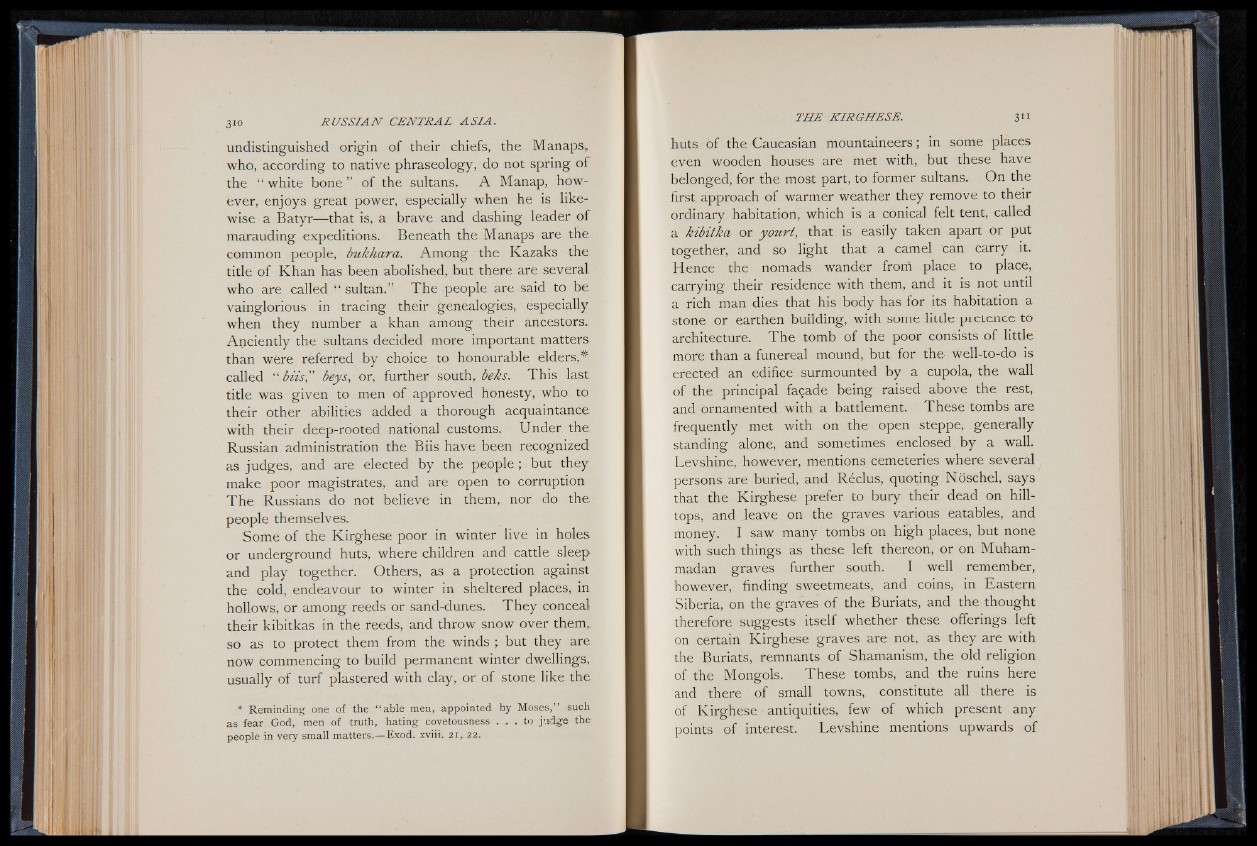
undistinguished origin of their chiefs, the Manaps,
who, according to native phraseology, do not spring o f
the “ white bone ” of the sultans. A Manap, however,
enjoys great power, especially when he is likewise
a Batyr— that is, a brave and dashing leader o f
marauding expeditions. Beneath the Manaps are the
common people, bukhara. Among the Kazaks the
title of Khan has been abolished, but there are several
who are called “ sultan.” The people are said to be
vainglorious in tracing their genealogies, especially
when they number a khan among their ancestors.
Anciently the sultans decided more important matters
than were referred by choice to honourable elders,*
called “ bus,” beys, or, further south, beks. This last
title was given to men of approved honesty, who to
their other abilities added a thorough acquaintance
with their deep-rooted national customs. Under the
Russian administration the Biis have been recognized
as judges, and are elected by the people ; but they
make poor magistrates, and are open to corruption
The Russians do not believe in them, nor do the
people themselves.
Some of the Kirghese poor in winter live in holes
or underground huts, where children and cattle sleep
and play together. Others, as a protection against
the cold, endeavour to winter in sheltered places, in
hollows, or among reeds or sand-dunes. They conceal
their kibitkas in the reeds, and throw snow over them,
so as to protect them from the winds ; but they are
now commencing to build permanent winter dwellings,
usually of turf plastered with clay, or of stone like the
* Reminding one of the “ able men, appointed by Moses,” such
as fear God, men of truth, hating covetousness. . . . to judge the-
people in very small matters.— Exod. xviii. 21, 22.
huts of the Caucasian mountaineers ; in some places
even wooden houses are met with, but these have
belonged, for the most part, to former sultans. On the
first approach of warmer weather they remove to their
ordinary habitation, which is a conical felt tent, called
a kibitka or yourt, that is easily taken apart or put
together, and so light that a camel can carry it.
Hence the nomads wander frond place to place,
carrying their residence with them, and it is not until
a rich man dies that his body has for its habitation a
stone or earthen building, with some little pretence to
architecture. The tomb of the poor consists of little
more than a funereal mound, but for the- well-to-do is
erected an edifice surmounted by a cupola, the wall
of the principal façade being raised above the rest,
and ornamented with a battlement. These tombs are
frequently met with on the open steppe, generally
standing alone, and sometimes enclosed by a wall.
Levshine, however, mentions cemeteries where several
persons are buried, and Réclus, quoting Nôschel, says
that the Kirghese prefer to bury their dead on hilltops,
and leave on the graves various eatables, and
money. I saw many tombs on high places, but none
with such things as these left thereon, or on Muhammadan
graves further south. I well remember,
however, finding sweetmeats, and coins, in Eastern
Siberia, on the graves of the Buriats, and the thought
therefore suggests itself whether these offerings left
on certain Kirghese graves are not, as they are with
the Buriats, remnants of Shamanism, the old religion
of the Mongols. These tombs, and the ruins here
and there of small towns, constitute all there is
of Kirghese antiquities, few of which present any
points of interest. Levshine mentions upwards of